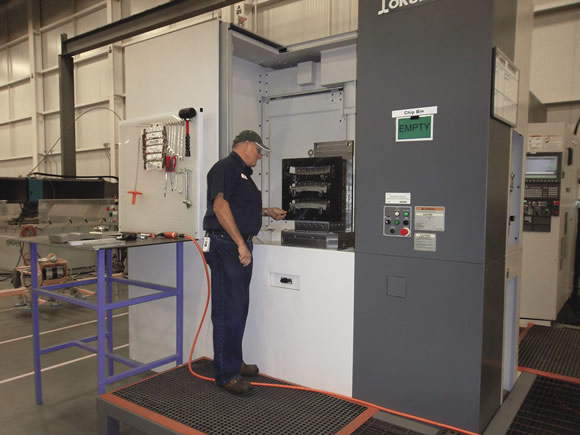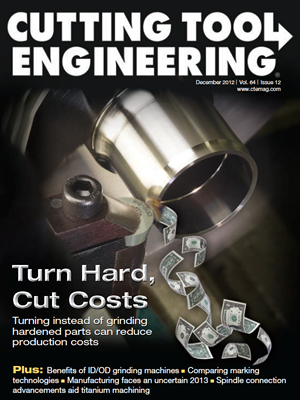Combustion components from Mitsubishi Power Systems had never been built outside of Japan until Savannah Machinery Works opened its doors in November 2010. We were in the unique and challenging position of having to develop every manufacturing process from scratch while maintaining a tight production schedule.
In other facilities where I have worked, it took up to 6 weeks to introduce a part to production even with established processes and workholding methods. At SMW, all parts were new, so we had to develop systems that enabled introduction of machining processes in days—sometimes hours. Working with variable part sizes complicated matters; they can be small enough to fit in the palm of your hand or as large as 400mm in diameter and weigh 200 lbs.
Flexibility is important because our product configurations require subassemblies to be machined between assembly-welding processes. Although shrinkage from welding is somewhat predictable, in-process dimensions are sometimes changed to accommodate variation from welding. Because dimensions are subject to change, we cannot fully commit to a machining process until the subsequent assembly is completed. Therefore, machining fixtures are often modified to accommodate dimensional changes during development.
Initially, I wanted to develop a workholding system that would function on all machine tools, but that wasn’t feasible during start-up. There simply was not enough time to address the challenges associated with designing and building a universal system for three horizontal machining centers, three vertical machining centers and three lathes. Instead, we developed one system for the machining centers and another for the lathes.
I started with the HMCs as they are more critical to production. Each HMC has two pallets. To establish a common foundation and maximize flexibility, I selected two four-sided tombstones for each of our two 500mm HMCs. Having four available sides allows simultaneously setting up multiple parts or accommodating parts with multiple operations. I selected a two-sided tombstone for our 600mm HMC machine.
All five tombstones have a 2 " hole pattern. Each hole is bushed to accept a 5/8 " dowel at the top and has a 5/8-11 thread below the bushing to accept a screw.
The 600mm HMC typically machines large weldments and parts that do not fit on the 500mm machines. I opted to mount the two-sided tombstone on the pallet where we mount large fixtures and left the second pallet empty for the weldments. Having the same pattern on all tombstones enables the smaller fixtures that typically run on 500mm machines to be placed on the 600mm machine, if needed.
The combustion shop has three VMCs: two 500mm and one 600mm. We plan to add grid plates to the VMCs. The grid plates will have the same hole pattern as the tombstones, so HMC fixtures can be mounted on the VMCs.
By utilizing the same mounting configuration on all machines, we have created a foundation for universal workholding. This foundation allows us to build fixtures that interface with every machining center by simply including provisions for pinning and bolting a fixture to a plate or tombstone. Universal mounting reduces the chance of lost production due to bottlenecks and helps prevent development from interrupting production.


Doug Wheeler, a machinist at SMW, prepares an Okuma MA-500H for production. Note the four-sided tombstone with multiple fixtures attached. Image courtesy of SMW.

Another important workholder is the milling vise, which should offer flexibility. One such vise has two pinholes in the base to allow it to quickly and accurately interface with a tombstone.
We make soft jaws for vises in-house by cutting blanks from 1 "-thick steel plate on a flatbed waterjet. During process development, we machine the blanks to the desired configuration and test the process. If the process is acceptable, we will make the jaws from a heat-treatable alloy and then harden them for production purposes.
For round parts, we purchased 15 "-dia., 6-jaw chucks with removable top jaws. Using lathe chucks on machining centers in not new, but we have been creative, sometimes treating them like dedicated fixtures by installing timing pins on the jaws or by using only two or three jaws to hold odd-shaped parts. We made chuck mounting plates with the 2 " hole pattern so the chucks could be quickly and accurately located on tombstones.
Turning is a challenge because most parts have large length-to-diameter ratios and are fabricated from sheet metal, which makes them inherently unstable. Our part configurations are not suited to secondary support with tailstocks or steady rests, which means we hold everything unsupported in 3-jaw hydraulic chucks supplied with the lathes.
In addition, finding soft jaws of the appropriate size and configuration for our operation is often impossible. Our solution is to weld pieces of cut plate onto standard serrated jaw blanks to increase their length or diameter, and then machine them like any other soft jaw. These fabricated jaws hold large assemblies securely, safely and reliably when turning.
As we continue process development, we are identifying processes that would benefit from dedicated lathe fixtures. We plan to partner with a tooling manufacturer that specializes in rotating toolholders and design a system with a base fixture that accepts part-specific turning fixtures, thereby providing a quick-change system comparable to the tombstones.
Having identical interfaces on all of the machines avoids bottlenecks by enabling us to move parts to underutilized machines. Stocking expensive components is not necessary, and we are not subject to running out of proprietary components because low-cost dowels, socket-head-cap screws, homemade vise jaws and standard soft jaws are all that’s needed to build fixtures.
One unforeseen benefit of our workholding system is the ability to transfer some of the fixture design from engineering to the shop, where experienced machinists and toolmakers can assist. Most importantly, we routinely move from concept to completion in a few hours. Having this flexibility has allowed SMW’s shop to cost-effectively maintain tight development schedules.
Related Glossary Terms
- bushing
bushing
Cylindrical sleeve, typically made from high-grade tool steel, inserted into a jig fixture to guide cutting tools. There are three main types: renewable, used in liners that in turn are installed in the jig; press-fit, installed directly in the jig for short production runs; and liner (or master), installed permanently in a jig to receive renewable bushing.
- centers
centers
Cone-shaped pins that support a workpiece by one or two ends during machining. The centers fit into holes drilled in the workpiece ends. Centers that turn with the workpiece are called “live” centers; those that do not are called “dead” centers.
- chuck
chuck
Workholding device that affixes to a mill, lathe or drill-press spindle. It holds a tool or workpiece by one end, allowing it to be rotated. May also be fitted to the machine table to hold a workpiece. Two or more adjustable jaws actually hold the tool or part. May be actuated manually, pneumatically, hydraulically or electrically. See collet.
- fixture
fixture
Device, often made in-house, that holds a specific workpiece. See jig; modular fixturing.
- gang cutting ( milling)
gang cutting ( milling)
Machining with several cutters mounted on a single arbor, generally for simultaneous cutting.
- lathe
lathe
Turning machine capable of sawing, milling, grinding, gear-cutting, drilling, reaming, boring, threading, facing, chamfering, grooving, knurling, spinning, parting, necking, taper-cutting, and cam- and eccentric-cutting, as well as step- and straight-turning. Comes in a variety of forms, ranging from manual to semiautomatic to fully automatic, with major types being engine lathes, turning and contouring lathes, turret lathes and numerical-control lathes. The engine lathe consists of a headstock and spindle, tailstock, bed, carriage (complete with apron) and cross slides. Features include gear- (speed) and feed-selector levers, toolpost, compound rest, lead screw and reversing lead screw, threading dial and rapid-traverse lever. Special lathe types include through-the-spindle, camshaft and crankshaft, brake drum and rotor, spinning and gun-barrel machines. Toolroom and bench lathes are used for precision work; the former for tool-and-die work and similar tasks, the latter for small workpieces (instruments, watches), normally without a power feed. Models are typically designated according to their “swing,” or the largest-diameter workpiece that can be rotated; bed length, or the distance between centers; and horsepower generated. See turning machine.
- machining center
machining center
CNC machine tool capable of drilling, reaming, tapping, milling and boring. Normally comes with an automatic toolchanger. See automatic toolchanger.
- milling
milling
Machining operation in which metal or other material is removed by applying power to a rotating cutter. In vertical milling, the cutting tool is mounted vertically on the spindle. In horizontal milling, the cutting tool is mounted horizontally, either directly on the spindle or on an arbor. Horizontal milling is further broken down into conventional milling, where the cutter rotates opposite the direction of feed, or “up” into the workpiece; and climb milling, where the cutter rotates in the direction of feed, or “down” into the workpiece. Milling operations include plane or surface milling, endmilling, facemilling, angle milling, form milling and profiling.
- turning
turning
Workpiece is held in a chuck, mounted on a face plate or secured between centers and rotated while a cutting tool, normally a single-point tool, is fed into it along its periphery or across its end or face. Takes the form of straight turning (cutting along the periphery of the workpiece); taper turning (creating a taper); step turning (turning different-size diameters on the same work); chamfering (beveling an edge or shoulder); facing (cutting on an end); turning threads (usually external but can be internal); roughing (high-volume metal removal); and finishing (final light cuts). Performed on lathes, turning centers, chucking machines, automatic screw machines and similar machines.


